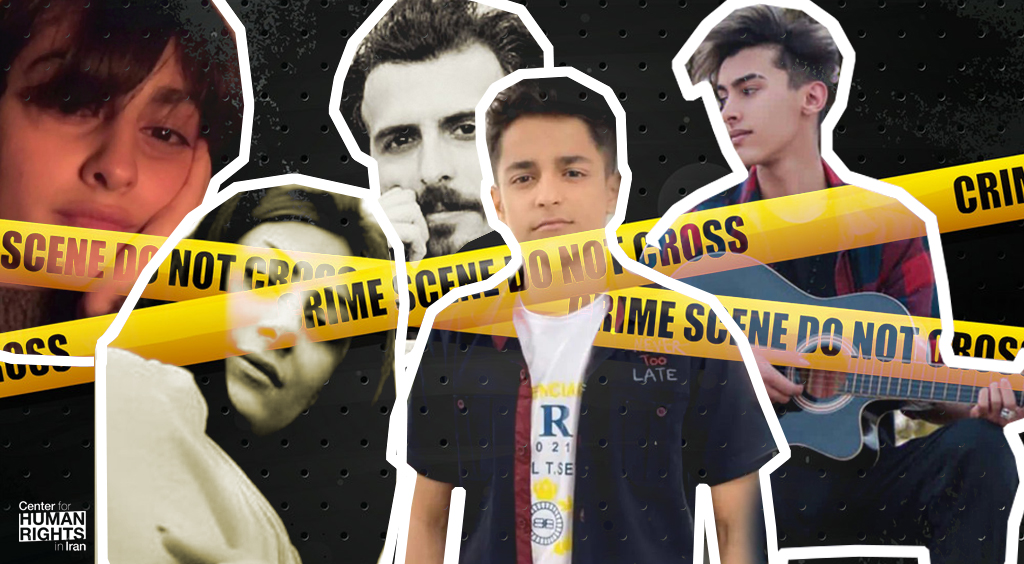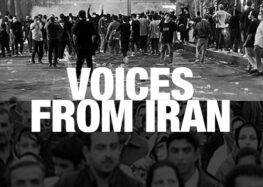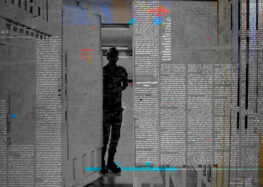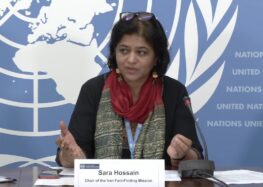Suspicious Deaths of Released Protesters in Iran Should be Investigated by UN
 Credible Evidence Challenges Iranian Authorities’ Claims of “Suicides”
Credible Evidence Challenges Iranian Authorities’ Claims of “Suicides”
Families Describe Visibly Tortured Bodies, Fabricated Evidence, Forced Quick Burials
January 19, 2023 – The UN Fact-Finding Mission should investigate the suspicious deaths of a number of recently released detained protesters, the Center for Human Rights in Iran (CHRI) said in a statement today, which Iranian authorities have labelled “suicides” despite significant evidence indicating otherwise.
“We are seeing a number of suspicious deaths of released detainees who were clearly tortured while in state custody, with families being forced to quickly bury their loved ones after being blocked from carrying out independent autopsies,” said CHRI Executive Director Hadi Ghaemi.
“Given the Islamic Republic’s documented history of killing or causing the death of detainees and trying to hide evidence, these deaths should be investigated by the Iran-focused UN Fact-Finding Mission,” said Ghaemi.
The fact-finding mission was established by the UN Human Rights Council in November 2022 to investigate the Islamic Republic’s gunning down of more than 500 men and women participating in the street protests that erupted across Iran after the September 2022 killing in state custody of 22-year-old Jina Mahsa Amini, as well as other crimes and rights violations committed by the Iranian authorities since then.
The alleged suicides, which all involve young women and men who were recently released from detention in connection with the ongoing anti-government street protests in Iran, have been characterized by counter claims by family members, countervailing evidence, and indications of severe mistreatment in prison, including beatings and forced injections of unknown drugs while in detention.
In some cases, family members who have spoken to CHRI have directly challenged the cause of death, stating that the so-called suicide was “staged.” In other cases, investigations by human rights organizations and journalists have produced evidence that the alleged suicides were cover-ups of murder by state security forces. In many of the cases, there are serious questions surrounding the events preceding the alleged suicide, including strong evidence of torture during detainment, which would have caused extreme emotional distress.
Following are several public cases that should be investigated by the UN Fact-Finding Mission.
Atefeh Na’ami
The alleged suicide of Atefeh Na’ami, 37, was “staged,” her brother Mohammad Amin Na’am, who is based in London, told CHRI in an interview, adding that Atefeh had “signs of torture on her body” and was “killed” and brought back to her apartment where her death was made to look like a suicide.
Atefeh went missing on November 20, 2022, Mohammad told CHRI, and was discovered dead in her home on November 26. Her family believes the authorities have denied that they had detained her to further create doubt over her “staged” death.
Authorities also destroyed evidence about her death and blocked the family from getting an independent autopsy, he said.
“Atefeh was actively participating in the protests,” he said. “She was identified as one of the protest leaders in Karaj. She had received threatening messages, which made her install cameras in her home. For security purposes, she also used a separate phone line whenever she called us.”
Na’ami’s body was discovered by her niece in Na’ami’s home on November 26, 2022, in her undergarments, on a couch with a blanket over her head and a gas pipe in her mouth.
“Our family has suffered a lot,” Mohammad said. “It was obvious to us that the suicide was staged.”
“The blanket they threw on Atefeh didn’t belong to her,” he added. “It was clear they had covered her with the blanket and brought her home after they had killed her.”
“The blanket disappeared a few hours after she was found because it had a ‘bad odor,’ [the authorities] said, even though it was criminal evidence,” Mohammad told CHRI. “My sister saw the signs of torture on Atefeh’s body.”
Mohammad added that Atefeh had shown no signs of emotional distress or depression.
“Atefeh was getting ready to attend our cousin’s wedding,” he said. “She had just recently bought a dress and talked about the wedding. She had also started reading one of Will Durant’s books on the history of religions. The point is that she had revolution on her mind, not suicide!”
“My sister was buried in a hurry on November 28 [2022], in the presence of just a few family members,” he told CHRI.
“The authorities had said the burial was going to take place at 1pm but it happened three hours early, next to our mother’s grave, in Beheshtabad Cemetery in Ahavz,” he added.
Abbas Mansouri
Abbas Mansouri, 19, died by suicide less than one week after he was released from 20 days in detention following his arrest in connection with the protests.
He had signs of “physical assault” on his body, a source with detailed knowledge of the case told CHRI, adding that the authorities forced the family to keep quiet about his death.
There are many unanswered questions about what happened to Abbas while he was detained, and why he would die by suicide just six days after being released.
“The uncle saw signs of physical assault on Abbas’s body when he was buried,” the source told CHRI after requesting anonymity to protect their personal security.
“They threatened the whole family and forced them to carry out the burial without informing the public,” added the source. “Why the worry and secrecy?”
Mansouri was arrested by state security agents during a protest in Shush, Khuzestan province on November 16, 2022, and charged with “distributing chocolate along with flyers” with the slogan “Woman, Life, Freedom” printed on them.
He was released on December 5, and on December 11 he was buried.
“Just like kids from his generation, Abbas was handing out chocolate, bumping fists and giving encouragement [at a protest] when suddenly the street was full of security agents who took him away along with several others,” said the source.
“When he was released 20 days later, he had become a recluse, hardly speaking a word. He told his family that the detainees were given pills and drug injections that they were told would make them sleep easier.”
“Then on December 11, Abbas took his own life with pills,” said the source. “He didn’t have any sickness and wasn’t the type to take narcotic drugs.”
Yalda Aghafazli
There are also serious questions surrounding the alleged death by suicide of Yalda Aghafazli, 19, who had said that she was severely beaten and mistreated in detention, and who died five days after her release from prison.
She was arrested on October 26, 2022, while she was writing political slogans on a wall in Tehran and taken to the notoriously harsh Gharchak Prison.
In an audio file that Yalda recorded after her release from detention, which was published on social media following her death, she said she was severely beaten during her arrest, prompting her to go on hunger strike for several days.
“I had never been beaten in all my 19 years as much as I was in those 12 or 13 days (in detention). I screamed so much I couldn’t talk but to the very last moment I never regretted [my actions],” she said.
News of her release from prison was made public on November 6 with a photo of her smiling outside the prison.
Five days later, she was found dead in her room.
Mohammad Shahriyari, who heads the Criminal Prosecution in Tehran, said she died of a pill overdose. But a source close to the family has disputed the claim, reported the BBC, adding that the family is still awaiting results of a toxicology report.
“Yalda was a self-made girl,” one of her friends told CHRI, adding that Yalda made a good living. “She never took narcotic drugs.”
“I knew her as an energetic person; suicide was out of the question,” added the source who requested anonymity to protect their personal security.
Arshia Emamgholizadeh Alamdari
Arshia Emamgholizadeh Alamdari, 16, was buried on November 27, 2022, after dying by suicide two days after he was released from detention in connection with the anti-state protests, during which he said he was tortured.
He had been arrested on November 12 for allegedly tipping a turban of a cleric’s head and was held in detention for 11 days in the Central Prison in Tabriz, East Azerbaijan province. He was released on November 23.
“They gave us pills at night and tortured us by beating the bottom of our feet,” Arshia said to his friends after being released, according to IranWire.
The report added that Alamdari had been prescribed pills during a visit to a doctor following his release from prison.
Again, his death cannot be separated from the serious allegations of torture in detention that preceded it.
In addition to the above cases involving recently released detainees, there have been other cases of deaths that have been labelled suicides by the authorities, but which independent investigations have put forth strong evidence of state responsibility for the deaths.
These include:
Sarina Esmaeilzadeh
Sarina Esmaeilzadeh was just 16 when she died in Gohardasht, Alborz province, after being “beaten in the head with batons” by state security forces, according to Amnesty International.
Yet Iranian authorities claimed the young video blogger had died by suicide after jumping off roof the same day she had joined anti-state protests, on September 23, 2022.
According to a “primary source” in Iran, Amnesty reported that “security and intelligence agents have subjected the girl’s family to intense harassment to coerce them into silence.”
Nika Shakarami
Nika Shakarami was also 16 when she disappeared after joining anti-state protests in Tehran on September 20, and was finally located by her family at a mortuary 10 days later.
An investigative report by CNN analyzing footage of Nika showed she was being hunted by state security forces before her death, which Iranian authorities again claimed was death by suicide, again by jumping off a building.
Her mother Nasrin had told Etemad, an independent Iranian newspaper, in an interview published on October 10 that she believed her daughter “was at the protests and killed there.”
“The Iranian authorities’ response to the current protests has been killing, mass arrests and executions; cover-ups of further murders or state-induced suicides would be a continuation of the same playbook of violent, lawless repression,” said Ghaemi.
Read this article in Persian






